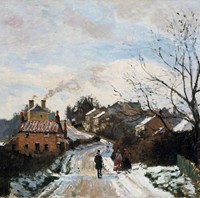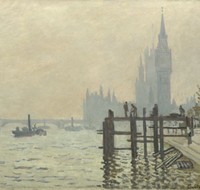|
|
Delacroix is known to have had a strong
influence on the painters of the group who sometimes were not afraid to
acknowledge it: Renoir, in the Salon of 1870, showed a "Woman of
Algiers," in which the striking colouring and even the composition
itself left no doubt about the admiration he felt for the master of Romanticism.
Delacroix's technique, particularly that offlochetage (flossiness), which
was like a pre-Divisionism, for long had attracted their attention, as
did observations such as this from about 1846 or 1847: "Constable
says that the superior green of his fields results from composition of
a multitude of different greens. What brings a lack of intensity and life
to the verdure of most landscapists is the fact that they usually paint
it in a uniform colour. What he says here about the green of his fields
may be applied to all tones."
The English landscape offers Monet and
Pissarro subjects which touch them deeply, but they also find themes for
meditation and discussion in the museums. Unfortunately our only information
on these points is from much later recollections and letters. In 1899
Signac, recording conversations with the two painters, wrote: "In
London ... they studied his [Turner's] work and analysed his technique.
They are struck primarily by his snow and ice effects. They are astonished
by the way he has succeeded in giving an impression of whiteness to the
snow, they who so far had not been successful with their big white patches
laid on with wide sweeps of the brush. They come to the conclusion that
this marvellous result is not obtained by using a uniform white but by
a large number of patches of different colour placed alongside one another
and, from a distance, giving the desired effect." Pissarro, in a
letter to Dewhurst in November 1902, wrote: "In 1870 I was in London
with Manet and we met Charles
Daubigny and Bonvin; Monet and I were enthusiastic about the London
landscapes. Monet was working in the parks while I, staying in Lower Norwood,
then a charming district, studied the effects of fog, snow and spring.
We were working from nature and later Monet painted in London some superb
fog studies. We also used to go to the museum. The watercolours
of Turner as well as the works
of John Constable certainly
had their effect on us. We admired Thomas
Gainsborough, Thomas Lawrence, Joshua
Reynolds and the others at the Royal
Academy, but we were particularly taken by the landscapists who were
nearer to what we were seeking in 'plein air', light and fleeting effects."
In a letter to his son on 8 May 1903, he also remarked: "Turner and
Constable, while useful to us, confirmed that these painters did not understand
the analysis of shadow which, in Turner's case, is always a deliberate
effect, a hole. As for division of tones, Turner confirmed its value as
a way of painting but not as the exact one." Much later on the aging
Monet, who alone has led Impressionism to its greatest importance, declares
that to his mind Turner's art is "antipathetic because of the exuberant
romanticism of his imagination".
Apparently one may attach more weight to
what Pissarro had to say because of the deeply scrupulous and exacting
mind of the artist and also because of the wealth of his detail. In 1870
what later was called Impressionism had barely taken shape. The movement
was still very fresh. If the enthusiasm of the painters in the group was
great and they were assured of their convictions, they nevertheless avidly
and gladly welcomed any support for their ideas. Pissarro, with just discernment,
uses the verb "to confirm". We can well believe that he and
Monet were happy to find confirmation of the correctness of their enterprise,
then in full development, in such a celebrated and admired master. They
still wondered about the manner of treating shadow, the division of tones
and the best technical means of securing the intensity of light they wanted.
Thus they found an ally in the works of Turner and Constable.
This is incontestable even if, the sketches of Turner and Constable, so
important in the eyes of the modern critic, were not yet to be seen at
that time in the London museums. For this reason Clark possibly goes too
far in minimising the contribution of British painters to Impressionism.
When Monet shows a certain reserve about Turner, he places it on the aesthetic,
not the technical level. On the other hand affirmations by Pissarro and
Signac are essentially on considerations of craft and are of a practical
and visual order. Finally, when Monet makes his declaration, he is near
the end of his life. Since that visit to London long ago the impressionist
technique has evolved, has become more explicitly formulated. Monet then
has another manner of envisaging the deep significance of his work.
To put things in their right perspective we may recall another statement
by Pissarro to Dewhurst: "Turner and Constable have been useful to
us as have all the great painters. But the basis of our art is indisputably
of French tradition. Our masters are Clouet, Nicolas
Poussin, and Claude Lorrain;
the 18th century with Chardin,
and the group of 1830 with Corot." It is also true that Impressionism
has developed far beyond Turner's ideas. He is a romantic. His imagination
ennobles the world. He becomes delirious before the effects of nature,
which he amplifies to the point of paroxysm. In his mind nature is transformed
into a vast whirlwind of forces in which man finds his place; it is presented
like a Byronic exaltation of the elements. But this world of raging or
flashing outbursts keeps its order; the paradoxes are respected. The painter
interprets it without destroying it, without placing before our intelligence
another way of conceiving our condition; the traditional manner of co-ordinating
the whole phenomena is not reversed. Impressionism, and Monet is fully
aware of it at the end of his career, has produced a revolution in vision.
Breaking away from criteria and conventions inherited from the classic
tradition, it has turned the order of things upside down to put man and
the universe into a new relationship. The evolution of art and thought
allow us today to see even better its full consequences.
On the material level also, the sojourn of Monet and Pissarro in London
was to have very great consequences; during this same period Daubigny,
also a refugee in England, paints views of the Thames which are a great
financial success and assure him of a living. Alarmed by the financial
problems which face Monet, he undertakes, perhaps in charity, to introduce
him to his dealer Durand-Ruel. The latter, who has left Paris and brought
his stock, has opened a gallery in New Bond Street. Durand-Ruel is interested
in the painters of the Barbizon
school. And he begins to consider the painters of the following generation
as the possible successors - Corot,
Diaz, Daubigny and Courbet.
Monet was not entirely unknown to him because in the International Review
of Art and Curia, published under his direction at the Paris
Salon of 1870, he had commented on the entries of Degas and Manet
as well as Sisley, Pissarro
and Monet, although Monet had been rejected by the jury. But in London
they come into direct contact and their friendship is established. Despite
financial difficulties which Durand-Ruel himself shortly has to face,
he greatly increases his efforts and attempts to support and put this
new painting on the market. In simple terms, Paul
Durand-Ruel was an exemplary art dealer: an expert lover of art, with
the courage of his own convictions, very sure taste, patient and tenacious,
daring to be the first and only one, not hesitating to risk his own fortune
on his choice. He was to play a decisive role in the survival, then the
triumph, of Impressionism.
NEXT: (7) Impressionist
Painting Developments Before First Exhibition.
Acknowledgements:
We gratefully acknowledge the use of an excerpt from Impressionism,
by Jacques Lassaigne (1966).
|


